The best recovery times for red light therapy depend on your specific goals. If you're targeting muscle recovery, aim for 15-20 minute sessions 3-5 times per week, with at least 24 hours between treatments. For morning sessions, you'll boost ATP production and enhance physical performance, while evening sessions can improve relaxation and sleep quality. Start with shorter 5-10 minute sessions to let your body adjust, then gradually increase to 15-30 minutes based on your needs. You'll want to maintain consistent timing and allow proper rest intervals of 1-2 days between sessions. Understanding the ideal treatment zones and intensity levels will help maximize your results.
Benefits of Post-Workout Light Therapy
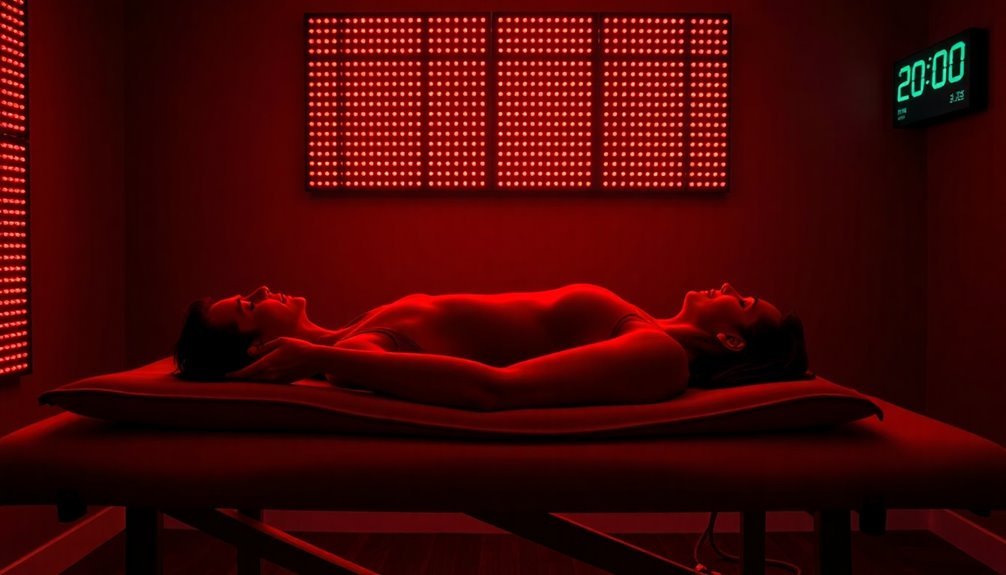
Looking into the benefits of post-workout light therapy reveals a powerful tool for athletic recovery. When you use red light therapy after exercise, you'll experience reduced inflammation and decreased muscle soreness, allowing your body to bounce back faster from intense workouts. The optimal wavelength range of 630-1200nm ensures maximum therapeutic benefits for muscle recovery.
The therapy works by boosting your body's natural recovery mechanisms. It enhances ATP production, which provides more energy for cellular repair, while simultaneously improving blood circulation to remove metabolic waste products like lactic acid.
You'll notice improved muscle function and faster adaptation to exercise stress, leading to better overall performance.
Red light therapy's impact on post-workout recovery is particularly significant. It accelerates muscle regeneration by stimulating muscle stem cells and promoting cellular repair.
You'll experience less delayed onset muscle soreness (DOMS) and reduced muscle pain due to the therapy's ability to decrease oxidative stress and enhance antioxidant production.
The benefits extend beyond immediate recovery. Regular post-workout light therapy sessions support long-term muscle health, reduce your risk of future injuries, and improve your body's ability to build and maintain muscle strength.
This makes it an invaluable tool for both serious athletes and fitness enthusiasts.
Optimal Recovery Session Length
Determining your ideal red light therapy session length depends on several key factors, including your age, physical condition, and the specific body area being treated.
If you're new to red light therapy, start with shorter 5-10 minute sessions to let your body adjust to the treatment. Professional treatment settings often provide structured therapy plans for optimal results. As you become more experienced, you can gradually increase your session length to 15-30 minutes.
For muscle recovery and pain relief, aim for 15-20 minute sessions, while skin health treatments typically require 10-20 minutes per area.
Your age and health status will influence the best session duration. If you're a young adult seeking general wellness benefits, 15-25 minute sessions should suffice. However, if you're older or dealing with chronic conditions like arthritis or fibromyalgia, you might need longer 15-30 minute sessions due to slower recovery processes.
Consider the treatment area's thickness when planning your sessions. Denser areas like your back, thighs, and joints require longer exposure times for effective results.
Remember to position yourself 10-15 cm from the light source and limit sessions to 3-5 times per week to prevent overuse and maintain the best benefits.
Morning Versus Evening Sessions
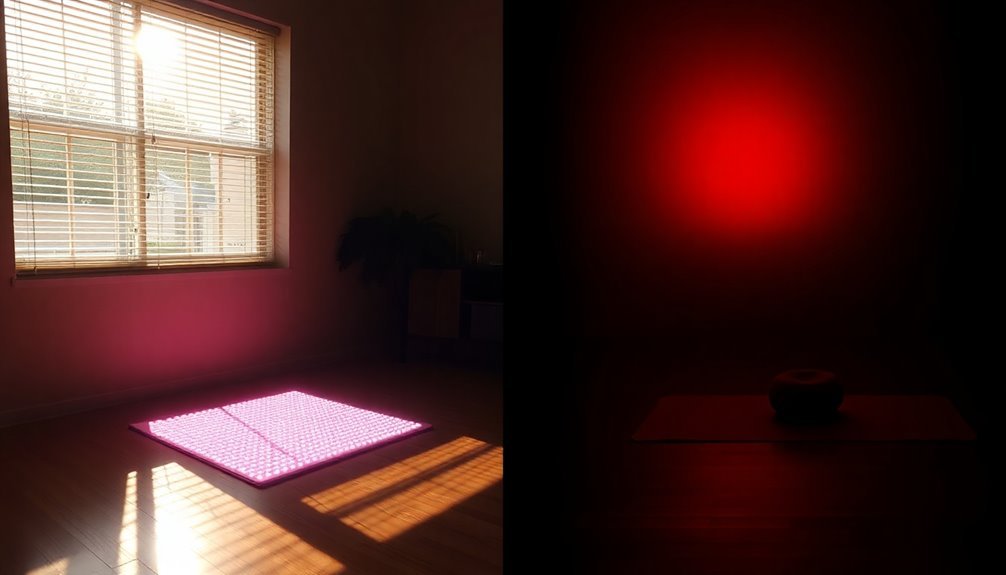
Timing your red light therapy sessions strategically can substantially impact their effectiveness and align with your wellness goals.
Morning sessions between 8:00 AM and 11:00 AM boost ATP production, enhance physical performance, and improve alertness throughout your day. If you're looking to optimize your workout routine, you'll find morning sessions particularly beneficial as a pre-workout boost. For optimal results, aim for 3-5 weekly sessions, spacing them consistently throughout your chosen timeframe.
Evening sessions offer different advantages, particularly for sleep quality and recovery. You'll benefit from enhanced melatonin production and better relaxation as your body prepares for rest. These sessions are ideal if you're focusing on repair mechanisms after daily activities and want to regulate your circadian rhythm for improved sleep.
Your choice between morning and evening sessions should depend on your specific objectives. If you're aiming for increased energy and performance, opt for morning sessions. If sleep quality and recovery are your priorities, evening sessions might work better.
However, consistency matters more than timing – choose a schedule you can maintain regularly. Pay attention to your body's response, as some people may be more sensitive to red light exposure in the evening, which could affect their sleep patterns.
Multiple Daily Session Guidelines
With your daily red light therapy schedule established, you'll want to know how frequently you can safely engage in multiple sessions. The general recommendation is three 20-minute sessions per day, though you'll need to adjust this based on your specific condition and device type. Using specialized goggles during each session is essential for protecting your eyes.
Your session duration will vary from 5-30 minutes depending on your device's intensity level and treatment goals. If you're using a high-intensity device, limit sessions to 1-5 minutes, while low-intensity devices allow for 10-20 minute sessions.
| Treatment Type | Recommended Frequency |
|---|---|
| Pain Relief | 3-5 sessions/week, 20-30 min |
| Wound Healing | 5-7 sessions/week, 10-20 min |
| Acne Treatment | 5-7 sessions/week, 10-20 min |
| Muscle Recovery | 3-5 sessions/week, 15-20 min |
| Chronic Conditions | 4-5 sessions/week, 15-20 min |
You'll need to space out your sessions throughout the day to avoid overexposure. Watch for signs of skin irritation or rashes, which indicate you should reduce frequency or duration. Once you've achieved initial results, you can decrease to 3-5 sessions per week for maintenance, ensuring consistent benefits without overstimulation.
Rest Between Treatment Sessions
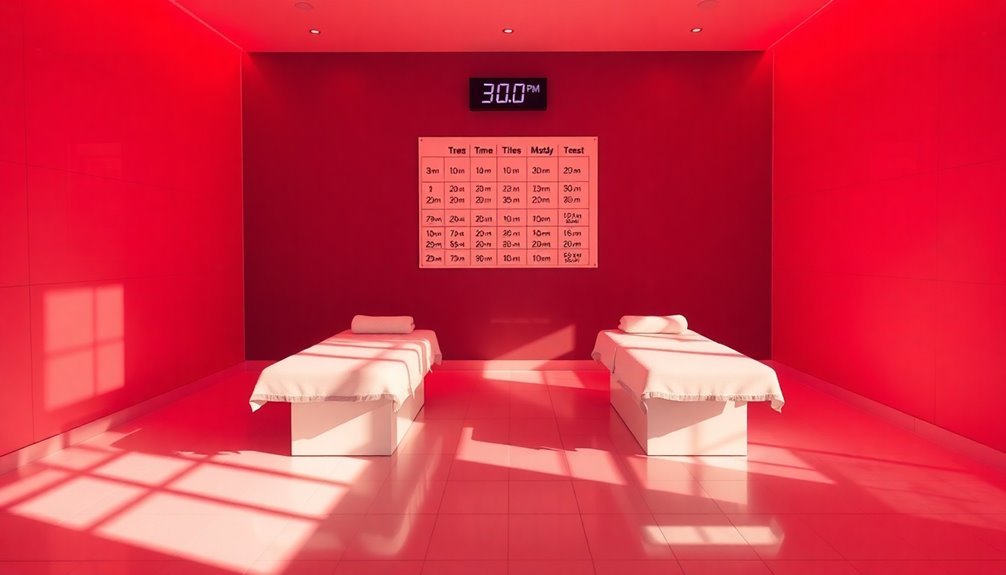
You'll need at least 24 hours between red light therapy sessions to allow your body's cells to properly respond to the treatment.
Ideal recovery intervals range from 1-2 days for general wellness treatments to daily sessions for wound healing, though you should always follow your device manufacturer's specific guidelines.
To prevent overuse, start with longer rest periods between sessions and gradually adjust based on your body's response, paying special attention to any skin sensitivity or irritation that may develop.
For skin health maintenance, schedule 2-3 weekly sessions once you've achieved your desired results.
Minimum Rest Time Required
Planning rest periods between red therapy sessions is crucial for maximizing treatment benefits while preventing overexposure. The required rest time varies depending on your treatment goals and condition.
For skin health and anti-aging treatments, you'll need at least one day between sessions, with a recommended frequency of 3-5 times weekly. If you're using red therapy for muscle recovery or pain relief, maintain a similar rest period of one day between treatments, keeping your sessions to 15-20 minutes for best results. Near-infrared wavelengths between 700 and 1100 nm penetrate deeper into tissues for enhanced recovery.
When treating wounds or injuries, you can use red therapy daily or every other day until healing is complete. While there's no strict rest requirement for wound healing, you should monitor your skin for any signs of irritation and adjust accordingly.
For general wellness and mental health benefits, you'll want to space your sessions with one day of rest between treatments, aiming for 3-4 sessions weekly. Each session should last 10-20 minutes. Remember that consistency is key, but you shouldn't exceed the recommended frequency as this could diminish the therapy's effectiveness and potentially cause skin irritation.
Consistency is key, but you shouldn't exceed the recommended frequency as this could diminish the therapy's effectiveness and potentially cause skin irritation.
Optimal Recovery Intervals
Understanding ideal recovery intervals helps fine-tune your red therapy treatment plan for maximum effectiveness. The best frequency varies based on your specific needs and treatment goals, but most conditions benefit from 3-5 sessions per week.
For general wellness, you'll want to schedule sessions 5 days a week, keeping each session between 15-20 minutes.
If you're targeting skin health or pain relief, aim for 3-5 sessions weekly, with durations of 10-20 minutes for skin treatments and 20-30 minutes for pain management. Wound healing requires more frequent attention, typically 5-7 sessions weekly. Enhanced mitochondrial respiration helps speed up the healing process significantly.
Your age also influences recovery intervals. If you're younger, you can achieve results with shorter 15-25 minute sessions, while older adults may need longer 15-30 minute sessions for maximum benefits.
Consider timing too – morning sessions boost energy and regulate your circadian rhythm, while evening treatments enhance relaxation and sleep quality.
For specific conditions like arthritis or fibromyalgia, maintain a schedule of 4-5 weekly sessions lasting 15-20 minutes.
Post-surgical recovery demands more frequent attention, with daily or alternate-day sessions of 10-15 minutes each.
Overuse Prevention Guidelines
In addition to following proper treatment schedules, preventing overuse of red light therapy requires careful attention to rest periods between sessions. You'll need to space your treatments at least 24 hours apart, with many experts recommending a 72-hour gap for best results and minimal irritation risk.
Start with shorter sessions to gauge your skin's reaction, particularly if you have sensitive skin. Multiple daily sessions should have at least 6 hours between treatments. You should maintain proper distance (15-50 cm) from the device and never exceed 120 joules of total exposure per session.
If you're treating general wellness concerns, limit your sessions to 3-5 times per week. For specific conditions like wound healing or acute injuries, you might need daily sessions initially, but you should reduce frequency to every other day for long-term use.
Set a timer for your sessions, which typically last 10-20 minutes, depending on your treatment goals and device intensity. Higher-intensity devices require shorter exposure times.
Watch for signs of overuse, such as redness, swelling, or heat-related burns. If you notice any irritation, increase the time between sessions and reduce exposure duration until your skin adjusts.
Signs of Effective Recovery
Recognizing effective recovery from red light therapy sessions involves monitoring several key indicators in your body's response. You'll notice enhanced cellular activity through improved muscle function and faster repair times, while experiencing reduced inflammation and soreness in treated areas.
Your body's natural healing processes become more efficient as circulation improves and metabolic waste products are removed more effectively.
Physical improvements serve as clear markers of successful recovery:
- You'll experience markedly reduced DOMS and muscle fatigue, allowing you to return to activities in nearly half the usual recovery time
- Your muscle performance and endurance will increase noticeably, accompanied by better overall physical function
- You'll observe decreased swelling and faster healing of any existing injuries
Beyond physical indicators, you'll likely notice improvements in your sleep quality and mental well-being. Enhanced melatonin production contributes to better rest, while reduced stress and anxiety levels signal your body's positive response to treatment.
Watch for improved skin health and reduced joint pain as additional signs that your red light therapy sessions are effectively supporting your recovery process.
Muscle Groups and Treatment Duration
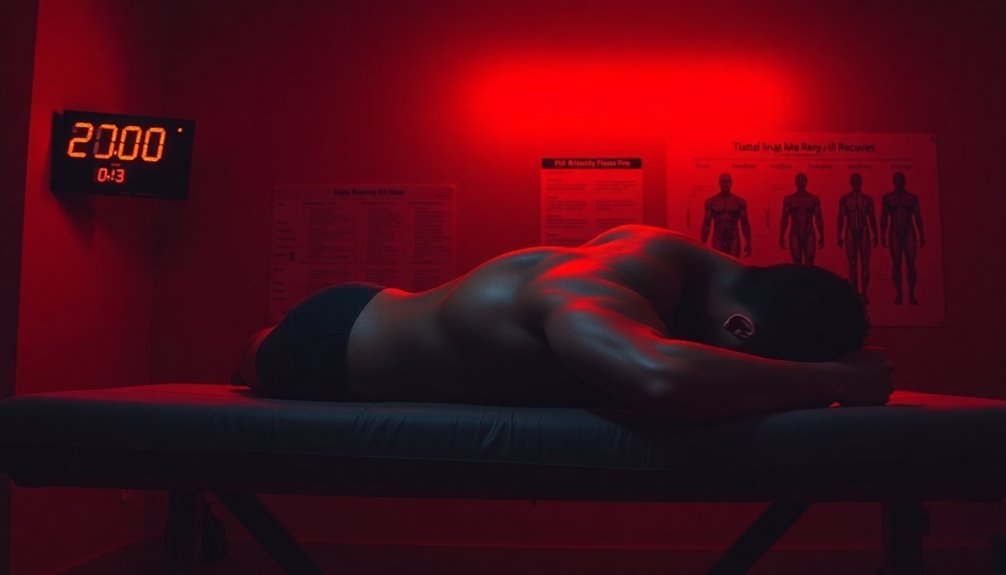
When you're planning red light therapy sessions, you'll need to adjust your treatment times based on the size of the muscle groups you're targeting.
Your smaller muscles like biceps require just 10-15 minutes with 20-60 joules per session, while larger muscle groups such as thighs need 15-20 minutes with 60-300 joules for ideal recovery.
You can maximize results by maintaining consistent sessions 3-5 times weekly, adjusting the duration and intensity according to your specific recovery needs and the power output of your device.
Major Muscle Recovery Times
The recovery times for major muscle groups play a critical role in maximizing the benefits of red light therapy sessions. Your upper body muscles, including chest, shoulders, and back, need 3-4 days of recovery before retraining, while leg muscles require 4-5 days for ideal results.
When you're planning your red light therapy schedule, it's essential to align it with these natural recovery periods.
To enhance your muscle recovery with red light therapy, follow these key timelines:
- Schedule 15-20 minute sessions 3-5 times weekly, particularly after intense workouts
- Allow at least 48 hours between training the same muscle groups
- Reduce session frequency to 2-3 times weekly for maintenance after initial treatment
You'll notice that upper body muscles show training effects after 3 days of rest, while lower body muscles need 4 days to demonstrate significant improvement. This difference in recovery times should guide your red light therapy scheduling.
Remember that individual recovery rates can vary, so pay attention to how your body responds. If you're dealing with chronic conditions like arthritis or tendonitis, maintain the full 15-20 minute session duration for deep tissue penetration.
Treatment Zones By Size
Successful red light therapy sessions depend heavily on matching treatment duration to muscle group size.
When treating small muscle groups like biceps and triceps, you'll need just 5-10 minutes using a handheld device positioned 6-12 inches from your body, with power outputs of 20-60 joules. Plan these sessions 3-4 times weekly for ideal results.
For medium-sized muscles like calves and forearms, extend your sessions to 10-15 minutes using either medium panels or higher-output handheld devices. You'll want to increase the power output to 60-120 joules and maintain the same 3-4 sessions per week schedule.
Larger muscle groups, such as thighs and back, require 15-30 minute sessions with full-body panels delivering 120-300 joules of power. You can increase frequency to 3-5 times weekly, especially when combining pre- and post-workout treatments for endurance training.
If you're doing full-body treatments, plan for 20-30 minute sessions using full-body panels. These thorough treatments should be done 2-3 times weekly for general wellness and recovery. Adjust the power output based on your device's specifications and your comfort level.
Session Length By Intensity
Building on muscle group sizing, intensity levels play a major role in determining ideal session duration. Your therapy goals directly impact how long you'll need to expose each area, whether you're preparing for a workout, recovering from one, or healing an injury.
For the best results, adjust your session lengths based on these intensity levels:
1. Low Intensity (Pre-Workout):
Keep sessions brief at 5-10 minutes per muscle group, using red light wavelengths (630-700 nm). You'll want to position yourself 6-12 inches from the device to achieve the right penetration depth.
2. Medium Intensity (General Wellness):
Aim for 10-20 minute sessions using either red or near-infrared light. You can apply this 3-5 times weekly for overall health benefits and stress reduction.
3. High Intensity (Injury Recovery):
Extend sessions to 15-30 minutes when treating injuries or during post-workout recovery. Use near-infrared wavelengths (700-1200 nm) for deeper tissue penetration, especially when targeting inflammation and muscle repair.
Remember to monitor your skin's response and adjust exposure times accordingly. If you're new to red light therapy, start with shorter durations and gradually increase as your body adapts.
Long-Term Recovery Strategies
Long-term success with red light therapy demands a well-structured approach that combines consistent treatment schedules with personalized adjustments. You'll need to tailor your session durations based on your specific recovery goals, with general wellness sessions lasting 10-20 minutes and chronic condition treatments requiring 15-20 minutes, 4-5 times weekly.
| Purpose | Duration | Frequency |
|---|---|---|
| General Wellness | 10-20 mins | 3-4x weekly |
| Muscle Recovery | 15-20 mins | 3-5x weekly |
| Chronic Conditions | 15-20 mins | 4-5x weekly |
To maximize your results, integrate RLT with other recovery methods. Schedule your sessions post-workout to enhance muscle repair and prevent overtraining. If you're using RLT for tissue regeneration or pain relief, you'll benefit from daily 10-15 minute sessions until healing is complete. For sleep and stress management, aim for 10-20 minute sessions, 3-4 times weekly.
Remember to adjust your treatment plan based on your age, physical condition, and comfort level. Older adults may need longer sessions, while younger individuals often respond well to shorter durations. Monitor your progress and modify session lengths according to your body's response.
Frequently Asked Questions
Can I Use Red Light Therapy While Taking Photosensitive Medications?
You shouldn't use red light therapy while on photosensitive medications without consulting your doctor first. These medications can increase your skin's sensitivity, potentially causing adverse reactions even with low-energy red light.
Does Skin Color or Pigmentation Affect Recommended Red Light Therapy Duration?
Yes, your skin color affects recommended red light therapy duration. If you have darker skin, you'll need slightly longer sessions, while those with lighter skin may require shorter exposure times for best results.
Should I Apply Moisturizer or Sunscreen Before or After Treatment?
You shouldn't apply moisturizer or sunscreen before treatment – wait until after. Apply your lightweight moisturizer first, then sunscreen last. This guarantees maximum light penetration during therapy and proper product absorption afterward.
Can Red Light Therapy Sessions Interfere With My Sleep Cycle?
Yes, red light therapy can affect your sleep cycle. While it's safer than blue light, evening sessions might increase alertness. For best results, you'll want to schedule your treatments in the morning hours.
How Does Altitude or Climate Affect Red Light Therapy Effectiveness?
You don't need to worry about altitude or climate affecting your red light therapy results. The treatment works through cellular mechanisms that aren't substantially impacted by environmental conditions like temperature, humidity, or atmospheric pressure.
In Summary
You'll get the most from your red light therapy by maintaining consistent sessions of 10-20 minutes and spacing them 4-6 hours apart when doing multiple treatments. Listen to your body's response and adjust timing accordingly. Whether you choose morning or evening sessions, stick to your schedule and monitor your recovery progress. Remember to give each muscle group proper exposure time for best results.

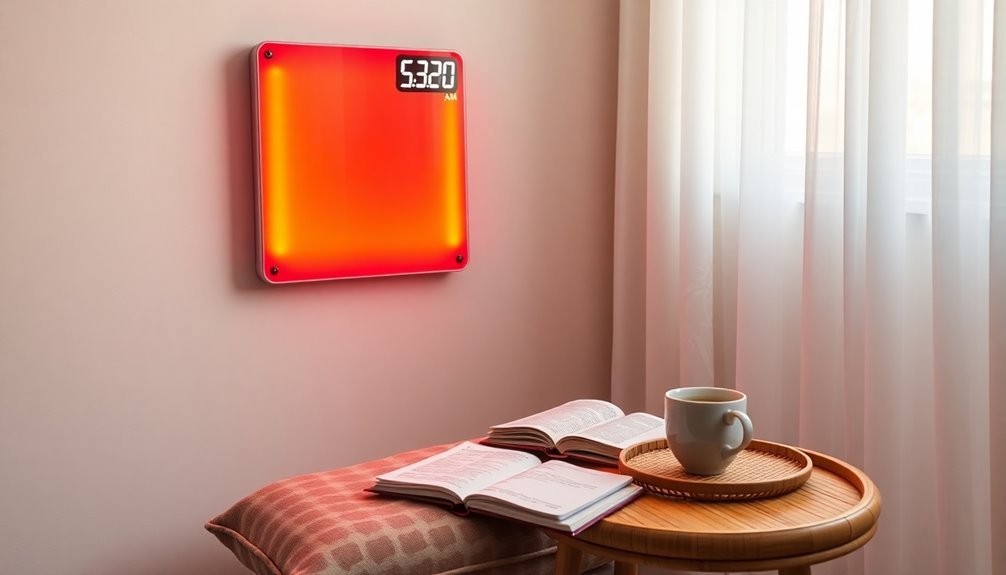



Leave a Reply